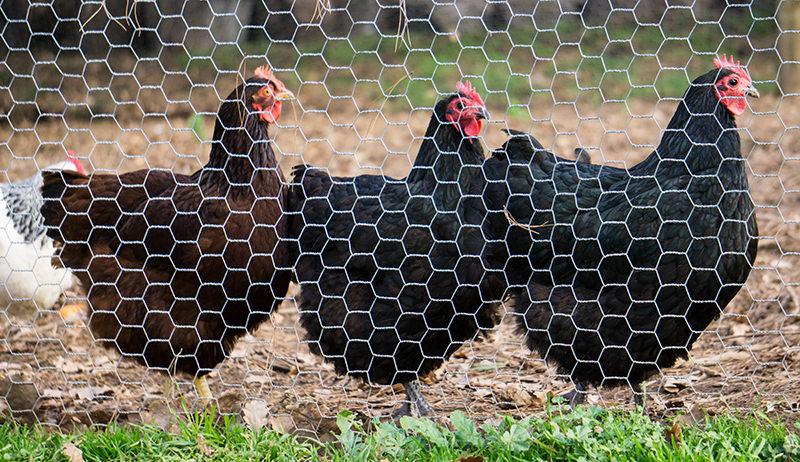CONFINEMENT AND YARDING
Confinement and yarding is when fencing is used to confine poultry to a smaller area than what they would normally range. This can also include housing to prohibit birds from venturing outside. In today's society, confinement and yarding is usually the best choice to raise poultry, especially if living in a rural community which neighbors a city limits. Birds do not understand property lines and can be a nuisance if they travel onto your neighbor's property. A yard also offers poultry a safe place to get fresh air and stretch their wings without them disappearing into other areas. Confining your flock to your property is considered being a good neighbor.
Another reason for fencing in small flocks is ease on the owner. It is much easier to keep track of your animals if you can rely on them being in the same area. Confining your birds is an excellent way to control feed intake of your birds. When supplied with a fresh, well-balanced ration everyday your birds are more likely to achieve optimum production. By observing your birds daily, you will be able to spot sick birds quickly. Once spotted, symptomatic birds can be removed before they make the rest of the flock sick. Confining poultry increases good flock health (only if good management practices are set in place).
Pasture Rotation
This is an excellent way to maintain a clean yard and healthy birds. There are several ways to rotate pastures/yards. One option is to have separate pastures with separate coops. You could have one coop that can access separate pastures with a gate that can be repositioned. Repositioning the gate will allow access to one pasture/yard while the others are blocked off. Another option is to use the same house, but have different doors on the coop to allow access to different pastures (Damerow, 1999). Using different doors instead of one door to access various pastures will avoid creating a bare dirt area in front of the entryway. By using a system with several doors, bare spots can easily be managed. To cover a bare spot, rotate birds to a new pasture or yard, throw some grass seed on the bare spot and it will fill in with a nice grass cover (just make sure to keep birds off until the cover has grown back).
Caging
Not all of us are fortunate to have lush yards to pasture our birds. We may be lucky to have enough yard to cut with the grass cutter. Another alternative to confining birds to a coop or yarding is to cage them. Caging birds can be less expensive than building a coop since cages can be kept in an already existing building. Some owners may choose to house their birds in cages so that the birds' diet and behavior can be carefully controlled. Many exhibit birds and show birds are caged.
Cages can be bought or built. Buying a cage is sometimes cheaper than building, but building your own cage allows freedom in deciding the dimensions and size.
If you choose to construct your own cage, here are the basic steps (Damerow, 1999).
-
Gather all your tools and materials you will need. To build or redesign a cage, you will need a latch, wire side cutters, cage clips or "ferrules", ferrule-closing pliers, and wire.
-
Cut the wire to the dimensions you want. Cut the top, bottom, and sides.
-
Assemble the frame. Clip the sides, top, and bottom together along the edges.
-
Cut out a door. Fourteen inch-square opening in the center of the front wall, two inches from the bottom. Make sure to file the edges smooth so that both you and the bird do not get scratched entering and exiting the cage. Use loose ferrules as hinges. If you hinge the door at the bottom, the door will drop down when opened, leaving your hands free to handle your bird. Fasten your latch, which can be fashioned from all sorts of things.
-
Cover the bottom of the cage. Cover part of the cage bottom with a board or heavy cardboard so birds can have an opportunity to rest their feet of the wire. This is especially important for heavier birds since their weight presses their feet into the wire. Dropping should be scraped from the cage at least once a week.
-
Secure cage in place. You can set your cage on a sturdy frame, attach it to a wall, or even hang from the ceiling as long as the cage does not move when the bird flaps around.
You can also incorporate roosts into your cage. Just remember that however high the roost is set, make sure to add the roost height to the top of the cage so that the bird does not rub its comb against the ceiling.
